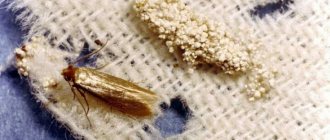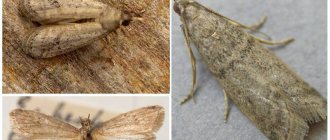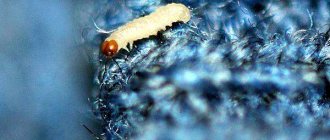Home Moth The moth is not as terrible as its little one
One of the most pressing problems on our agenda may be the eradication of such an unpleasant pest as moths.
Insects are always unwanted guests at home, let alone moths, which can cause considerable material harm to the owners of the apartment. Thus, questions about what moths and their larvae are afraid of, and how to deal with different types of this domestic dirty trick, are very relevant.
We will discuss the degree of threat of this pest appearing in the house, and also try to find out how to get rid of moth larvae and adult butterflies, and what is the difference between them.
- Appearance of the pest
- Image and stages of life
- How they harm
- What are they afraid of?
- Conclusion
Appearance of the pest
For many decades, these small moths have been considered by people to be among the most inveterate pests both in the domestic environment and in agriculture. However, today we will talk exclusively about domestic species of these insects, such as clothes moths and food moths.
Both species are almost identical in appearance. This is an inconspicuous and inconspicuous-looking butterfly, most often of a grayish-pale color, which cannot even be called a color. It's like a powdered, light yellow or just gray moth, without any traces of beauty, as they say.
Although there are still some differences between these two species. Usually the food variety is darker in color than the wool variety. The kitchen moth has brownish blotches on its wings, while the house moth is completely light-colored.
The body length of these butterflies usually does not exceed 1 cm. They are poor flyers and have difficulty moving through the air over long distances. We can say that these are endemic to interior spaces, such as living rooms, kitchens, warehouses, storage rooms, verandas and the like.
Image and stages of life
These insects are characterized by multi-level metamorphism. That is, during the course of their existence, they go through several stages of their development with a complete change in appearance and internal structure.
There are 4 such stages in total, we list them:
- butterfly;
- egg;
- caterpillar;
- doll
It all starts with an adult insect, which, by the way, does not pose a threat to any of our kitchen supplies, natural indoor utensils, or fur clothing.
The moth butterfly lives extremely short, and its natural purpose is solely to participate in the process of reproduction and preservation of the population of the species. Moreover, the moth does not even have mouthparts for eating; it does not feed at all.
The male insect participates in mating, while the female takes responsibility for laying eggs in a secluded place suitable for the further development of her litter.
The eggs of these pests are not much different from most other insect clutches. These are white oval-shaped rounds, almost invisible to the human eye, with an embryo inside visible under a magnifying glass.
As a rule, moth eggs mature during the working week while maintaining the ambient temperature within 20-25 degrees. When the temperature drops, the ripening period may increase.
After the specified period, barely noticeable moth larvae, reminiscent of former threads, emerge from the eggs. And here we will go into a little more detail. After all, it is these small creatures that are a real disaster for their owners, since caterpillars themselves are a feeding form of insect life.
They are incredibly voracious, and it seems that their whole point is to constantly eat food. This is also indicated by the structure of the oral apparatus of moth larvae, which consists of 2 mandibles, very massive in comparison with the size of the caterpillar itself, capable of gnawing even tissue fibers and solid food products that are quite strong, as for an insect.
After gaining sufficient weight, the fat larva begins to prepare for pupation. She weaves a cocoon around herself, after which she falls into hibernation, during which the last round of metamorphic transformation occurs in the life of the moth with the transformation into a butterfly.
How they harm
As we said earlier, all the harm to this insect comes precisely from the moth larvae. This applies to almost all varieties without exception. Gluttonous caterpillars are capable of ruining not only your mood with their harmful actions, but also an expensive piece of clothing or furniture, causing a blow to your wallet.
Clothes moths are by far the most dangerous of all types of household pests. The larvae of this butterfly feed on fibers of natural materials, which can be found in expensive items of clothing, such as a fur coat, or in the upholstery of high-quality furniture sets. Carpets, stuffed animals and even books also suffer from the tricks of these pests.
Larvae can also eat synthetic materials, but such nutrition can only be temporary for lack of anything else. Synthetics are more likely to harm the caterpillars, slowing down their development, but this does not make it any easier for us.
Moreover, these voracious creatures can also chew passages for movement in the fibers of a carpet or fur coat, thereby leaving clearly visible lines and bald spots.
The damage caused by food moth larvae is, of course, less destructive in material terms, but more unpleasant in moral terms. These caterpillars consume almost everything they can find in the kitchen.
They do not touch except garlic and hot spices, but the rest is quite suitable for the larvae as a food source.
Getting rid of the pest
Revision.
The first step in getting rid of food moths is to conduct a thorough inspection of all bulk products stored in the house. Before refilling your closet with bags and jars, you must carefully examine the contents of each package. Sort through, pour undamaged items into tightly sealed containers and discard packages that show signs of contamination. Before reusing cereal storage containers in which insects have been found, they should be thoroughly washed with detergent.
Resuscitation of stocks.
If only a small part of the volume is damaged, you can try to save the cereal in one of the following ways:
- Fry in a frying pan or in the oven. At temperatures above 60 ̊ C, moth larvae die within 60-90 minutes.
- To freeze. The larvae die after 2-3 days at temperatures below 10 ̊ C.
But it’s better, of course, not to save money and immediately get rid of the contaminated product.
Cleaning.
The second thing is to carry out a general cleaning of the storage area for bulk products. To do this, wash the entire surface of the kitchen cabinets with soapy water. Especially carefully you need to wash all hard-to-reach places in the cabinet: far corners, various cracks, recesses, door hinges. This is where cocoons of food moths can hide and are easy to miss. After treating with a soap solution, you should thoroughly wipe the entire surface with a vinegar solution so that the moth does not want to re-settle in this place. After this procedure, you need to leave the cabinet doors open for ventilation.
What are they afraid of?
Here it must immediately be said that an adult moth butterfly and its caterpillar are two different creatures, and their perception of certain factors as a threat to life is very different.
Aromaprophylaxis
It is much easier to fight a butterfly, and even easier to prevent its appearance in the house. To achieve this, many proven folk methods have been used very successfully for many decades, most of which are based on repelling insects with unpleasant odors.
We list all the main sources of such aromas that repel these pests.
These include the following:
- citrus fruit peel;
- laundry soap;
- vinegar;
- geranium flowerpots;
- tansy and wormwood inflorescences;
- dried lavender or its oils;
- fragrant tobacco;
- garlic cloves
Among these remedies, we note the excellent preventive effect of laundry soap, as well as the smell of garlic. These products are available to everyone, and perfectly perform their repellent function against adult insects.
And lavender, by the way, is even used as a flavoring agent in the creation of special chemical moth repellents.
Sunlight and high temperature
If aromatic protection, by and large, helps well in repelling adult insect pests, then intolerance to light and sunlight has an equally detrimental effect on both butterflies and moth larvae.
As a preventive measure, and simply when fighting pest larvae already found in an apartment, an excellent way to get rid of them is by airing and frying items of clothing, for example, in the sun in hot weather. Even after hanging a fur coat at less than 30 degrees, most caterpillars die in the sun's rays or are easily blown away by the wind.
Also a good way to destroy insect larvae and eggs is to wash items at the maximum permissible water temperature. If we are talking about furniture or carpet, you can use a technical hair dryer to blow hot air.
In general, temperature can be considered our ally in the fight against these pests. At a temperature of 45-50 degrees, the moth will certainly die, including adults, larvae and eggs.
Frost and cold are our friends
Are moths afraid of frost? Don't even doubt it. This insect fears sub-zero temperatures even more than light and heat. Already when the ambient temperature drops to 10, the insect feels very uncomfortable. The rate of development of larvae and maturation of pupae slows down significantly, while adult butterflies begin to look for more favorable conditions for laying eggs.
When the thermometer stops at zero, insects and their larvae usually die, or, in the best case for them, are on the verge. If the room temperature is minus, this is already a death sentence for insects of all types and their caterpillars.
Chemical weapons against pests
The most reliable method of influencing this pest would be, of course, the use of chemical agents to kill moths and other indoor insects.
These include all kinds of sprays and aerosols, as well as evaporative insecticides.
Let's start with the last ones. Fumigators have proven themselves to be excellent repellers and destroyers of flying insects such as mosquitoes, flies and moths.
The principle of operation of such products is to evaporate special plates or liquids using heat.
Thus, the insecticide they contain either kills insects indoors or forces them to look for a fifth corner.
Among such evaporators, the well-known fumigators and Raptor plates perform well.
This manufacturer is an absolute leader in the field of creating means of protection and control of insects in the vastness of the CIS countries.
If we talk about spray sprays, there are also a number of recognized options that have good reviews from users, including the following:
- Antimol;
- Armol;
- Raptor “Protection from moths”;
- Dichlorvos NEO or BUNTOKS;
- Moskital “Protection against moths”;
- "Clean house".
In a word, there is a choice. All of these products serve their purpose equally well; the difference may be in price and degree of harm to humans and pets. This is definitely the most compelling answer to the appearance of moths in the house, be it butterflies or even their larvae.
However, not everyone wants to use insecticide spraying in the kitchen, even if in the specifications of some aerosols manufacturers assure that the product is completely safe for humans. Still, you need to understand that getting a toxic substance into food or on the dinner table is not good.
Therefore, let us once again recall the preference of fighting food moths in the kitchen using preventive methods and evaporative fumigators. In any case, make your own decision here and at your own risk.
OUR READERS RECOMMEND!
To get rid of insects, our readers recommend the Pest-Reject repeller
. The operation of the device is based on the technology of electromagnetic pulses and ultrasonic waves! Absolutely safe, environmentally friendly product for humans and pets. Read more here...
Moth larvae: description
Moths are small scaly butterflies that appear both in the kitchen and in other rooms. A flying butterfly is a signal that you need to look for a place where it breeds. For a normal existence, apartment conditions are ideal for moths. It's warm here, and there's plenty of food. Therefore, the moth will definitely lay eggs (up to 100 eggs in one clutch). In this regard, it is not difficult to imagine what will remain of the life activity of this pest colony if nothing is done.
Signs of moths:
- Moths feed on various wool products, which provides a favorable environment for their life. Moreover, such things should not contain any synthetics.
- As a result of the activity of the larvae, large holes appear in knitted items and they become unusable.
- Moth larvae are worm-like caterpillars of off-white color with a yellowish tint. Caterpillars have tiny legs on their bodies.
- The larva has a darker head. If you look at it through a microscope, you can see quite powerful jaws.
- The larvae grow quite quickly, reaching a length from 3-4 mm to 6-7 mm.
- As a rule, the larvae feed in one place and practically do not move. Movement was observed in very small larvae, still young.
- A small area may contain a large number of eggs and several grown larvae. These pests leave behind large, chewed holes in various things. Products cannot be restored.
- Clothes, fur coat, carpet and furniture moths can be distinguished by their characteristic cocoon, in the form of a miniature case consisting of material residues and their own adhesive secretions. In this cocoon, the larva moves through woolen products and does its job. The furniture moth builds a more decent cocoon from the remains of its vital activity. The food moth also equips a cocoon for itself, but it is much more primitive and thinner.
- Growing larvae take refuge in shaded areas and rarely emerge. In this regard, taking this factor into account, you can fight moths if you take all things out into the sun so that they are pierced by direct sunlight. In direct sunlight, both larvae and eggs die.
- The voracious larvae actively develop at temperatures of +22…+25 degrees. Below +13 degrees and above +30 degrees, the development of this parasite stops and the larvae die. The development of eggs also stops. The larva develops within 90 days if conditions are favorable for this. At temperatures not lower than +13 degrees, the cycle is reduced to 60 days.
- Food moths develop somewhat faster due to more nutritious food. During its development cycle, it molts 4 times.
- If the housewife rarely looks into the closet, the result can be disastrous: damaged items made of natural wool or fur are unlikely to be worn by anyone.
Moth larvae / Moth larva











